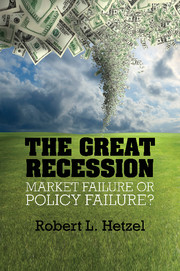Book contents
- Frontmatter
- Contents
- Figures
- Tables
- Preface
- One The 2008–2009 Recession
- Two Recessions
- Three The Great Contraction
- Four Monetary Policy and Bank Runs in the Great Depression
- Five Vigorous Recovery and Relapse
- Six Interwar International Monetary Experiments
- Seven Identifying the Shocks that Cause Recessions
- Eight From Stop-Go to the Great Moderation
- Nine Controlling Bank Risk Taking
- Ten The Housing Crash
- Eleven Bubble Trouble
- Twelve What Caused the Great Recession of 2008–2009?
- Thirteen What Caused the Great Leverage Collapse?
- Fourteen The Distinctions Between Credit, Monetary, and Liquidity Policy
- Fifteen Fed Market Interventions
- Sixteen Evaluating Policy
- Seventeen The Business Cycle
- Eighteen Why Is Learning So Hard?
- Nineteen How Should Society Regulate Capitalism?
- Postscript
- Bibliography
- Index
Fifteen - Fed Market Interventions
The Experiment with Credit Policy
Published online by Cambridge University Press: 05 May 2012
- Frontmatter
- Contents
- Figures
- Tables
- Preface
- One The 2008–2009 Recession
- Two Recessions
- Three The Great Contraction
- Four Monetary Policy and Bank Runs in the Great Depression
- Five Vigorous Recovery and Relapse
- Six Interwar International Monetary Experiments
- Seven Identifying the Shocks that Cause Recessions
- Eight From Stop-Go to the Great Moderation
- Nine Controlling Bank Risk Taking
- Ten The Housing Crash
- Eleven Bubble Trouble
- Twelve What Caused the Great Recession of 2008–2009?
- Thirteen What Caused the Great Leverage Collapse?
- Fourteen The Distinctions Between Credit, Monetary, and Liquidity Policy
- Fifteen Fed Market Interventions
- Sixteen Evaluating Policy
- Seventeen The Business Cycle
- Eighteen Why Is Learning So Hard?
- Nineteen How Should Society Regulate Capitalism?
- Postscript
- Bibliography
- Index
Summary
For Chairman Bernanke (1983), monetary shocks caused the Great Recession. Frictions in financial markets (the credit channel) were important as a propagation mechanism. Later, as FOMC chairman and in the context of the 2001 and 2008–2009 recessions, he adopted the view that the initial shocks originated as the bursting of bubbles in asset markets. In response to a question from Henry Kaufman asking “[H]ow will the Federal Reserve respond to further financial speculative activities,” Bernanke (2009d) responded:
You just introduced perhaps the most difficult problem in monetary policy of the decade, which is how to deal with asset bubbles. We’ve had two big asset bubbles in this decade, and both have resulted in severe downturns, particularly the credit bubble.
Based on the assumption that the 2008–2009 recession originated in a disruption in financial markets, Bernanke (2008b) provided the rationale for the unprecedented intervention into credit markets by central banks and governments in fall 2008:
History teaches us that government engagement in times of severe financial crisis often arrives late, usually at a point at which most financial institutions are insolvent or nearly so. Waiting too long to act has usually led to much greater direct costs of the intervention itself and, more importantly, magnified the painful effects of financial turmoil on households and businesses.
- Type
- Chapter
- Information
- The Great RecessionMarket Failure or Policy Failure?, pp. 282 - 299Publisher: Cambridge University PressPrint publication year: 2012



